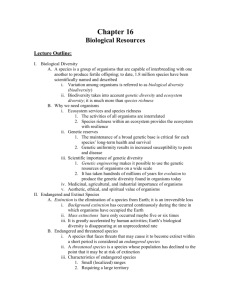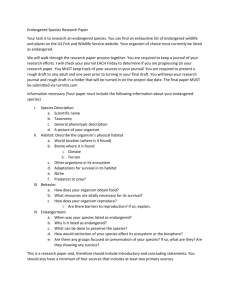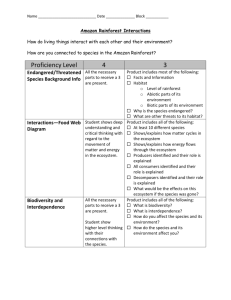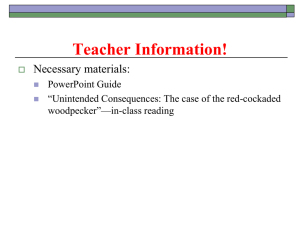Chapter 16 - Crowley AP Environmental Science
advertisement
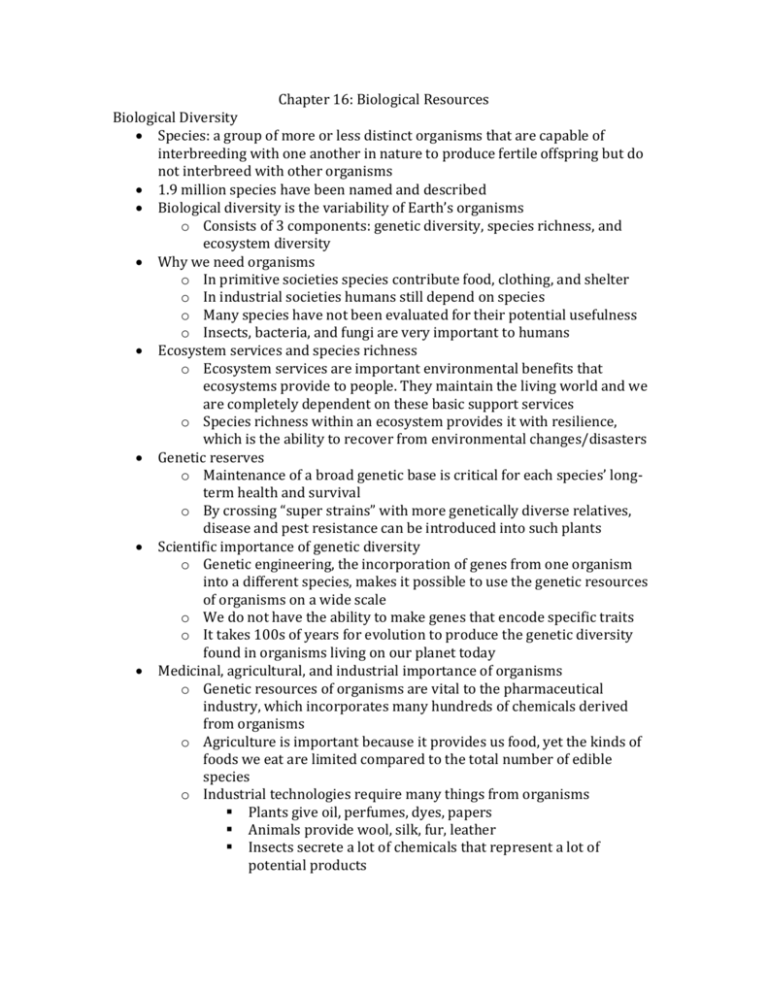
Chapter 16: Biological Resources Biological Diversity Species: a group of more or less distinct organisms that are capable of interbreeding with one another in nature to produce fertile offspring but do not interbreed with other organisms 1.9 million species have been named and described Biological diversity is the variability of Earth’s organisms o Consists of 3 components: genetic diversity, species richness, and ecosystem diversity Why we need organisms o In primitive societies species contribute food, clothing, and shelter o In industrial societies humans still depend on species o Many species have not been evaluated for their potential usefulness o Insects, bacteria, and fungi are very important to humans Ecosystem services and species richness o Ecosystem services are important environmental benefits that ecosystems provide to people. They maintain the living world and we are completely dependent on these basic support services o Species richness within an ecosystem provides it with resilience, which is the ability to recover from environmental changes/disasters Genetic reserves o Maintenance of a broad genetic base is critical for each species’ longterm health and survival o By crossing “super strains” with more genetically diverse relatives, disease and pest resistance can be introduced into such plants Scientific importance of genetic diversity o Genetic engineering, the incorporation of genes from one organism into a different species, makes it possible to use the genetic resources of organisms on a wide scale o We do not have the ability to make genes that encode specific traits o It takes 100s of years for evolution to produce the genetic diversity found in organisms living on our planet today Medicinal, agricultural, and industrial importance of organisms o Genetic resources of organisms are vital to the pharmaceutical industry, which incorporates many hundreds of chemicals derived from organisms o Agriculture is important because it provides us food, yet the kinds of foods we eat are limited compared to the total number of edible species o Industrial technologies require many things from organisms Plants give oil, perfumes, dyes, papers Animals provide wool, silk, fur, leather Insects secrete a lot of chemicals that represent a lot of potential products Aesthetic, ethical, and spiritual value of organisms o Organisms provide mental health benefits, recreation, inspiration, and spiritual solace o Artists, writers, and poets have tried to capture the beauty of the physical world o Parks and green space promote psychological well-being Extinction and Species Endangerment Extinction: the death of the last individual of a species Extinction is irreversible During the time span in which organisms have occupied Earth, a continuous, low-level extinction of species, or background extinction, has occurred A mass extinction has occurred maybe 5 or 6 times Endangered species act 1973 Endangered and threatened species o Endangered species are a species that faces threats that may cause them to become extinct within a short period of time o A threatened species is a species whose population has declined to the point that it may be at risk of extinction o Endangered and threatened species represent a decline in biological diversity, long term survival requires genetic diversity Characteristics of endangered species o Characteristics include small range, having low reproductive success, having specialized feeding habits o Habitat fragmentation is a major threat to long-term survival of many species Where is declining biological diversity the greatest problem? o Declining biological diversity is a concern throughout the US, but it is most serious in Hawaii (63% of species are at risk) and California (29% of species are at risk) o Tropical rain forest in south and central America, central Africa, and southeast Asia are also subject to declining biological diversity Earth’s biodiversity hot spots o Norman Myers coined the term biodiversity hotspots Biodiversity hotspot: relatively small areas of land that contain an exceptional number of endemic species and are at high risk from human activities o Meyers and ecologists identified 25 biological hotspots Human causes of species endangerment o In 2001 the United Nation requested a Millennium Ecosystem Assessment in order to gather information about ecosystem changes and the effects of these changes on human well-being o Biological diversity is declining rapidly due to several factors The greatest threat to biological diversity is land use change Land use change o Most species faced with extinction today are endangered because of the destruction, fragmentation, or degradation of habitats by human activities o As the human population grows, more species face endangerment o Little habitat remains for endangered species Invasive species o Biotic pollution is the introduction of a foreign species into an ecosystem in which it did not evolve These often upset the balance among the organisms living in that area and interfere with the ecosystems normal functioning o The foreign species competes with native species o Humans are usually responsible for invasive species Overpopulation o Species can come extinct or endangered as a result of deliberate efforts to eradicate or control their numbers Ranchers, hunters, and government agents are some of the people that cause this Poaching is a major threat o Commercial harvest is the collection and sale of live organisms from nature These end up in zoos, aquaria, biomedical research laboratories, circuses and pet stores o Wild bird conservation act of 1992 imposed a moratorium on importing rare bird species Pollution o Humans produce acid rain, stratospheric ozone depletion, and climate change All of these degrade the environment o Climate change is caused by an increase of carbon dioxide in the atmosphere o Pollution can cause deformities in animals Conservation Biology Conservation biology is the scientific study of how humans impact organisms and of the development of ways to protect biological diversity A single large area of habitat is generally more effective at safeguarding an endangered species than several habitat fragments It is more effective to work on preserving intact ecosystems In situ conservation (on-site conservation) concentrates on preserving biological diversity in nature o Conserving is the single best way to preserve biological diversity o Protected areas are not always effective in protecting biological diversity Developing countries o 11.5% of Earth’s land area has been set aside to protect biological diversity Ex situ conservation (off-site conservation) involves conserving biological diversity in human-controlled settings Connecting fragmented habitats o Habitat corridors are strips of habitat that connect isolated habitat fragmented These are also called wildlife corridors o Restoration ecology is the study of the historical condition of a human-damaged ecosystem, with the foal of returning it as close as possible to its former state Zoos, aquaria, botanical gardens, and see banks o All of these save individual species who are on the brink of extinction o Artificial insemination is when sperm is collected from a suitable male of a rare species and used to artificially impregnate a female o Embryo transfer is when a female is treated with fertility drugs, then the eggs are collected and fertilized with sperm Reintroducing endangered species to nature o Only one of every 10 reintroductions using animals raised in captivity is successful o Once animals are released the have to be monitored Seed banks o Seed banks, or gene banks, are more than 100 seed collections o Seeds to do not remain alive indefinitely and must be germinated periodically so that new seeds can be collected o The biggest disadvantage to seed banks is that plants stored in this manner remain stagnant in an evolutionary sense Conservation organizations o These group educate policymakers and the public about the importance of biological diversity Conservation Policies and Laws Endangered species act was passed to authorize the US Fish and Wildlife services to protect endangered and threatened species in the US and abroad The ESA requires the FWS to select critical habitats and design a detailed recover plan for each species listed Habitat conservation plans o Habitat conservation plans: the 1982 amendment of the ESA provided a way to resolve conflicts between protection of endangered species and development interest on private property o The habitat conservation plan allow a landowner to take a rare species if the taking does not threaten the survival or recovery of the threatened or endangered species on that property International conservation policies and laws o The World Conservation Strategy is a plan designed to conserve biological diversity worldwide o The Convention on Biological Diversity was produced to decrease the rate of extinction of the worlds endangered species National conservation strategy: a detailed plan for managing and preserving the biological diversity of that specific country o The Convention on International Trade in Endangered Species of Wild Flora and Fauna controls the exploitation of endangered species internationally Wildlife Management Wildlife management: the application of conservation principles to manage wild species and their habitats for human benefit or for the welfare of other species Attention is focused on common organisms Management of migratory animals o International agreements are established to protect migratory animals Flyways: established routes of migration Arctic snow geese o The artic snow goose is a major challenge for wildlife manager because its population expanded rapidly beginning in the 1980s o The pop. Migrates south during the autumn and spends winters in salt marshes in Texas and Louisiana o Wildlife managers want to avoid a massive die-off of geese in the Arctic so they need to reduce the population Management of aquatic organisms o Fishes with commercial or sport value must be managed to ensure hey are not overexploited to the point of extinction o During the 19th and 20th centuries whale species were harvested to the point of commercial extinction, which is when so few remain that it is unprofitable to hunt them

